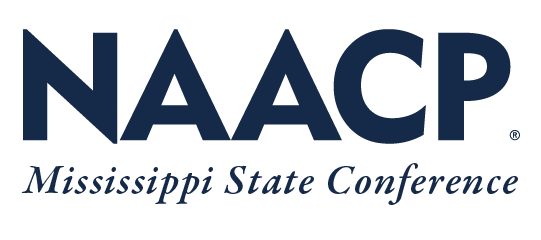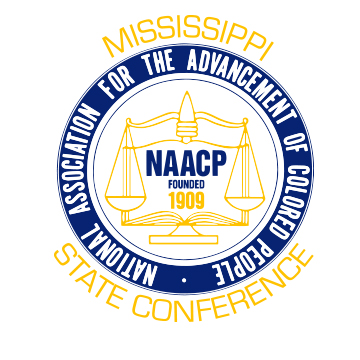The Mississippi State Conference NAACP and HURRICANE KATRINA
It was Sunday and the first warnings to evacuate had already come down. Katrina was going to make landfall. Most people on the coast were still debating whether to evacuate or ride the storm out and with the two previous false alarms, this threat was treated with a certain ambivalence by many residents. Among the debaters were James Crowell, State Treasurer and President of the Biloxi Branch of the NAACP, and his wife. It wasn’t until that night that the decision was made to leave. They would go to Atlanta to stay with their son.
They left just in time.
Hurricane Katrina hit the Mississippi Coast shortly before lunch the next day.
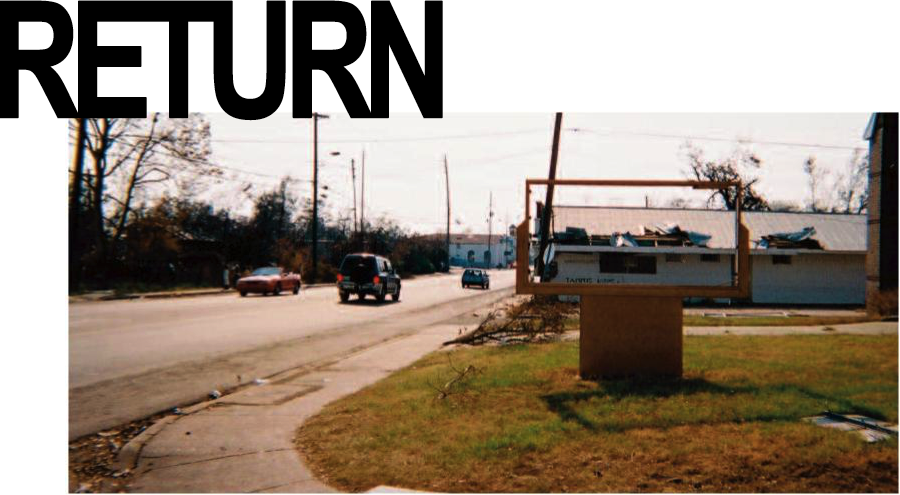
It was Tuesday that the Crowells returned to the coast.
What they found was devastation. Katrina had been thorough. Though their house had survived structurally, it was no longer livable. The interior had been completely flooded by storm surges – the same powerful surges that destroyed or similarly flooded the homes of their neighbors, snatched automobiles away in their currents, and washed away personal possessions as well as lives.
James Crowell surveyed the damage around him, noting what was needed most and by whom. He then made his way over to the nearby Main Street Missionary Baptist Church, where over 120 residents, mostly senior citizens, had huddled together in that place of worship to ride out the storm, retreating from the first floor to the second when the storm waters came. There he met with Reverend Kenneth Haynes, Pastor of Main Street Missionary Baptist Church and Reverend Maurice Davis, Pastor of Tabernacle Missionary Baptist Church, and together the three of them formed a plan on how to help those most affected by the storm, those who could not or did not evacuate. Haynes set up a makeshift camp and sleeping quarters in front of the church while Davis organized the search and salvage teams who tracked down survivors and recovered as much food as possible, as both would perish under the intense August heat. James Crowell’s mission was to seek outside help.
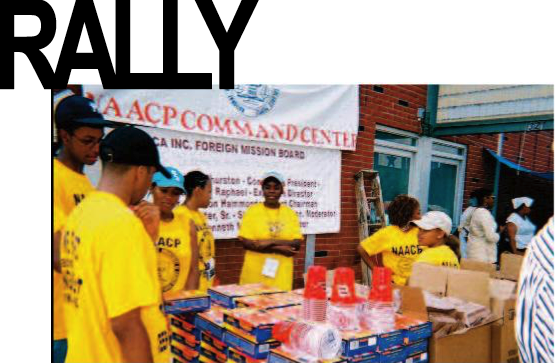 College Chapter members setup in front of Main Street Missionary Baptist Church. MS-NAACP setup a commend center at the church to coordinate its efforts on the coast.
College Chapter members setup in front of Main Street Missionary Baptist Church. MS-NAACP setup a commend center at the church to coordinate its efforts on the coast.
He called the President of the Mississippi State Conference NAACP.
It was Wednesday that the Mississippi NAACP got involved. Without electricity and with limited gas, communications had been shoddy at best and information was hard to come by on just how awesome was the damage done to the coast. It was Crowell’s report that communicated the dire situations of the coast residents.
They had no power. They had no gas. There were no supplies or support to the small community of poor, mostly elderly, mostly African Americans on the peninsula of East Biloxi. The Red Cross wasn’t there. FEMA wasn’t there.
Spurred to action, the State NAACP, successfully coordinating with its regional office in Atlanta, sent three truck loads with necessary supplies including food and fresh water. Under Charles White, Regional Director for the NAACP, volunteers and supporters from the metro
Atlanta area drove in trucks with supplies and essentials, while local NAACP members in Jackson and North Mississippi organized relief efforts and sent down fresh help. However, there was a problem. The Gulf Coast was under martial law and no vehicles were allowed down Highway 49 to the ravaged coastline unless they carried an emergency permit deeming them “essential.”
The rally cry went out and was quickly answered. Members of the Mississippi Legislative Black Caucus, including State Representative Kelvin Buck (who also served as an NAACP State Vice President), State Representative Earle Banks, State Representative Tyrone Ellis, and other Caucus members lent their aid to acquire the necessary permits and have the NAACP listed as one of the few entities considered essential for relief efforts.
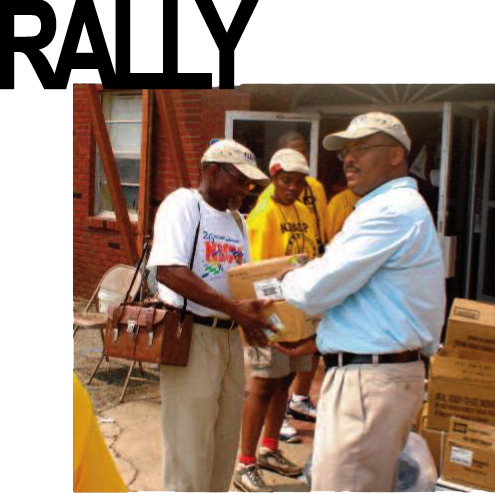 State Representative Kelvin L. Buck (Holly Springs) and State Representative Rufus Straughter (Belzoni) unload supplies at Main Street Missionary Baptist Church with the assistance of College Chapter members from the Atlanta University system.
State Representative Kelvin L. Buck (Holly Springs) and State Representative Rufus Straughter (Belzoni) unload supplies at Main Street Missionary Baptist Church with the assistance of College Chapter members from the Atlanta University system.
The others were law enforcement, the National Guard and the Red Cross.
National President Bruce Gordon met with then President George W. Bush, explaining the need for a rapid response in the affected poor, minority communities. Gordon coordinated with the Mississippi NAACP to arrange for a tour of the area to see the devastation first hand. However, roadways were nearly impassable, and many times the National Guard would have to use bulldozers to clear narrow strips through which vehicles could pass. The Gulfport airport was restricted to essential aircraft, and only limited traffic was available through the Jackson airport.
Despite these obstacles, Gordon was able to secure passage on a private jet through a pharmaceutical company that committed essential medicines like insulin, but the plane was too large to land at the heavily damaged coast airport. Instead, the plane flew into Jackson. As a result, Columbus, MS attorney and long-time member Will Colom sent his private plane to Jackson to fly Bruce Gordon, Derrick Johnson, Tavis Smiley, and the medicine down to the Gulfport airport after obtaining yet another special permit from the National Guard to fly into the unlit airfield. Tavis Smiley was in Jackson trying to get to Gulfport to check on his sister from whom he had not heard.
By Saturday, the Mississippi State Conference NAACP had organized a relief effort and acquired the necessary access to send help to the residents of East Biloxi including 18-wheelers full of supplies and essentials, two caravans of volunteers (one from Atlanta and the other from Jackson), and a private plane full of medical supplies. Volunteers traveled back to Jackson, where they were housed by attorney Isaac Byrd because there was no housing available. The following day volunteers returned to the coast to unload supplies at Little Rock Baptist Church in Gulfport, MS. On Monday, a third 18-wheeler delivered supplies to St. Paul United Methodist Church in Moss Point, MS, an effort coordinated by then State Representative Billy Broomfield.
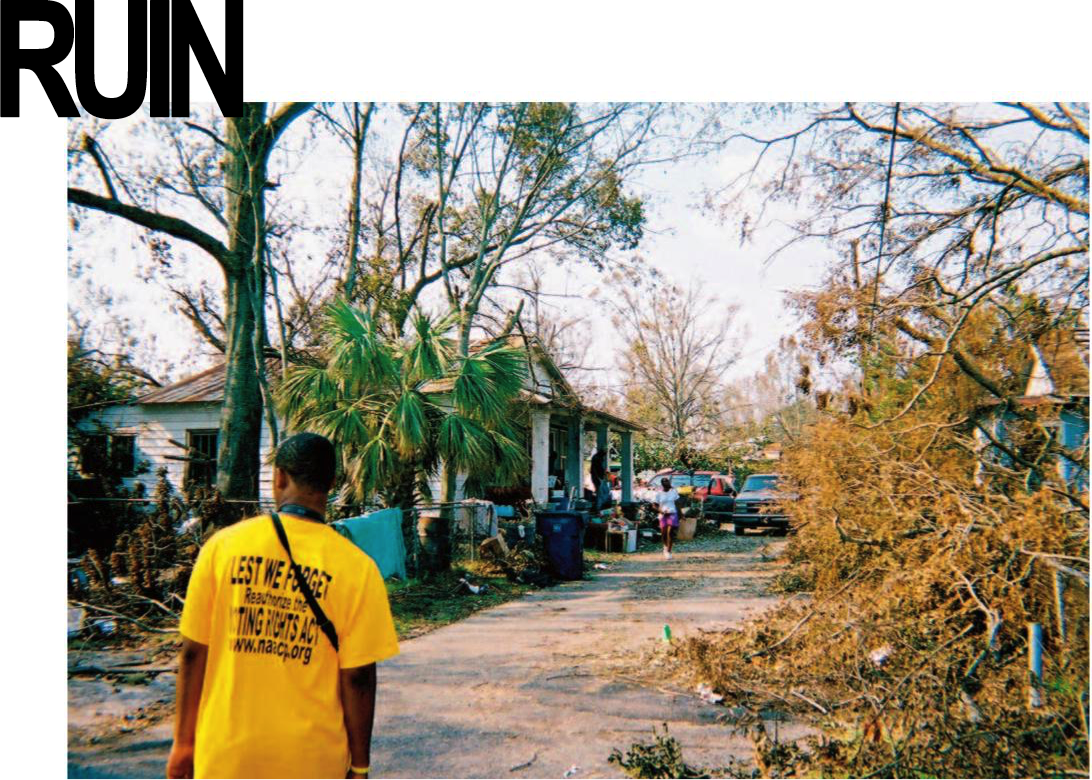 Damaged street in East Biloxi Community
Damaged street in East Biloxi Community
It was Friday when Oxfam America contacted the NAACP seeking to get to the coast, as the organization had been unable to obtain the necessary permits. Minor Sinclair, U.S. Program Director of Oxfam America, met the Jackson delegation in the Target parking lot early on Saturday morning.
The sight that greeted the delegations in East Biloxi was one of utter devastation. Many structures were gone or so damaged as to be unsafe and unsalvageable. Food was dwindling due to lack of refrigeration, and most people were forced to cook what food they did have on grills or makeshift grills. The fresh water supply was depleted, and the Red Cross had not provided any support.
By this time, five days later, FEMA had finally sent an assessment team, but provided no support. The Salvation Army had begun to provide bottled water, and the Red Cross had yet to be seen. As a result, the NAACP delegations bringing the much-needed relief of food, water, blue tarps, and other essentials were met by residents in a state of emergency and desperation. It was then plain to many that the recovery supports were not being spread equally among the affected communities. Poor and African American communities had received little and often no assistance from any of the major relief organizations. These areas included not only East Biloxi, but also North Gulfport and Moss Point. Within two weeks, the NAACP set up twenty-two distribution sites across the Katrina-affected area because of the lack of equity in response.
 Casino barge washed ashore by the storm.
Casino barge washed ashore by the storm.
Days later, many things had yet to change. With many of the casinos closing and nearly all businesses destroyed, unemployment was rampant among Gulf Coast residents.
In response to this, the NAACP coordinated an aggressive campaign with Congressman Bennie Thompson demanding that FEMA first hire unemployed residents of the coast to fill its temporary positions before hiring out-of-state applicants.
The campaign was successful.
In a rural community in Walthall County, nearly three weeks later, there was still no power. Once this was brought to its attention, the NAACP sent food, water, and other supplies to the county, where residents greeted the arrival with critical urgency and earnest desperation. This was a turning point. As it soon became clear that the NAACP was the only organization with the necessary infrastructure and agility to address the needs of the post-Katrina poor and minority communities, other organizations began to ally themselves with the NAACP to better facilitate their efforts.
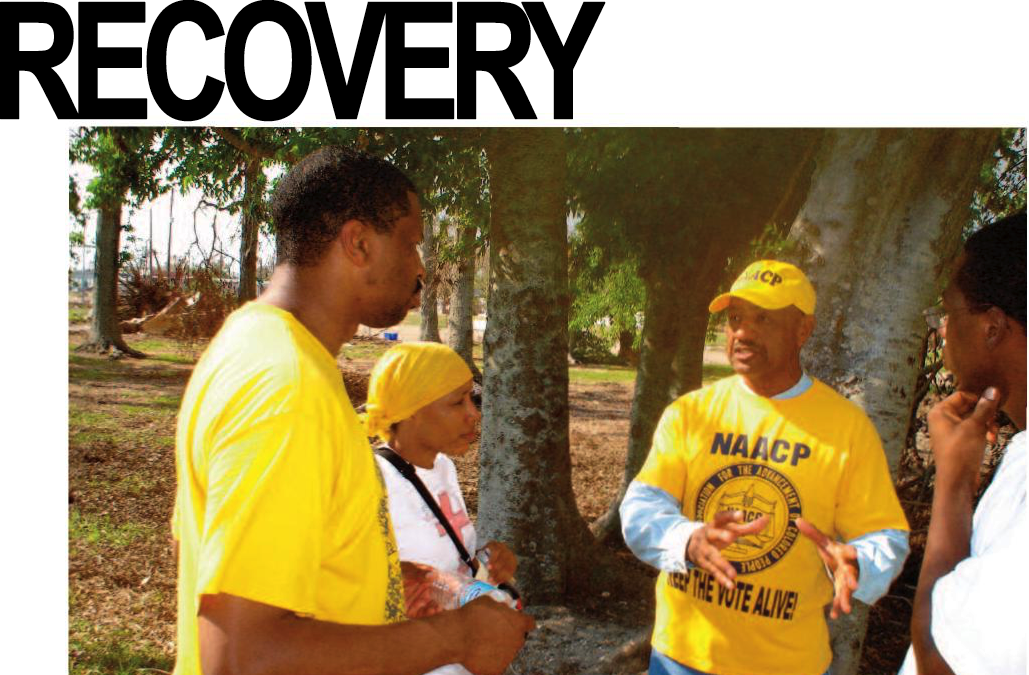 State President Derrick Johnson and 1st Vice-President Charles Hampton discuss immediate needs with community leaders.
State President Derrick Johnson and 1st Vice-President Charles Hampton discuss immediate needs with community leaders.
As result of the NAACP’s work in the aftermath of Katrina, President Derrick Johnson was invited to serve on the Governor’s Recovery Commission. As a member of the Commission, Johnson worked to be a voice for communities that were being left out of the discussion, resulting in a strong push to make sure that the report included affordable housing needs for renters, those living on fixed incomes, and affected senior citizen populations.
Further time on the Commission revealed to Johnson and the NAACP that lack of legislative oversight regarding the spending of federal recovery funds – which nearly exceeded the general annual budget for the entire state – was a significant problem. As a result, the NAACP quickly returned to its role as an advocacy organization rather than a relief or service organization.
By researching and convening policymakers, community leaders, and allied organizations, the NAACP began to focus on how Community Development Block Grant (CDBG) funds would be used for the recovery. In partnership with the Mississippi Center for Justice, the MS State Conference NAACP filed a lawsuit and, after several years of litigation, was successful in settling for approximately $132 million that went directly to benefit home renters and other individuals who were left out of the previous recovery efforts.
The crisis following Hurricane Katrina’s landfall answered many critics’ questions about NAACP relevance in Mississippi. The resulting discovery was that, not only did it still have relevance, but in the days following Katrina, the NAACP became the lifeline between many affected individuals and their survival. The establishment of those initial recovery centers provided individuals with fresh water and food much sooner than they otherwise would have had them. Those early centers meant individuals had access to information on how to get shelter and clothing much more quickly than from any other source. It was the connective tissue of the NAACP that prevented many poor, elderly, and minority communities from being left out of the recovery effort. Relationships like those the
NAACP has, with black churches, allowed the swift setup of support centers in devastated communities.
